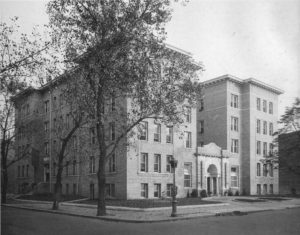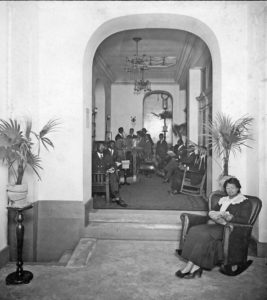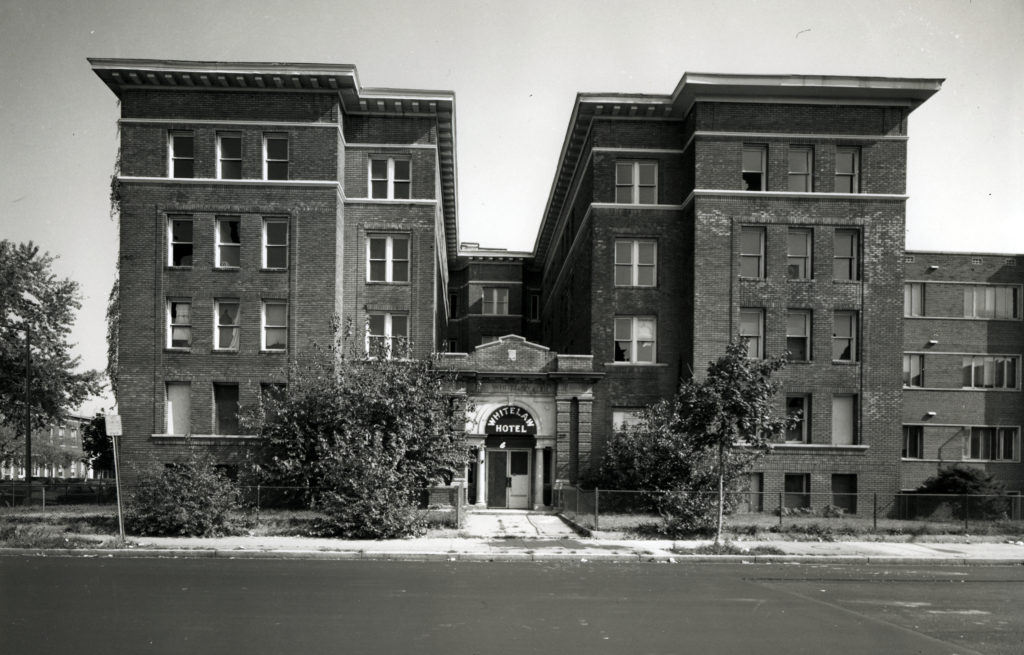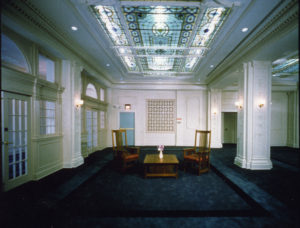This “Place of Interest” blog post honoring Black History Month looks back at the dramatic story of a hotel built by and for African Americans in 1919. It is adapted from “Like a Phoenix’: The Rebirth of the Whitelaw Hotel,” by Patricia M. Cook, published in Washington History magazine 7-1 (spring/summer 1995).
Jean Bess was eight years old in 1940 when she moved into Apartment 404 in the Whitelaw Hotel. One of 16 children, Jean had been sent to Washington from Selma, Alabama, to live with her childless aunt Ella King. At the time, their home at 1839 13th Street NW was central to African American cultural life in Washington, with hotel and apartment accommodations and an elegant ballroom for social events. Life in the Whitelaw provided the young girl with enough excitement and activity to keep her busy every night of the week.

“I would tell my aunt whenever I knew they were going to have an affair here . . . because they were down here decorating,” Jean recalled in 1994. And during the parties, “the doors would always be slightly open. And I would always peep into the ballroom . . . and see all the ladies in their beautiful sequined and beaded gowns and the men in their formal wear. . . . I would see the ladies dancing and chatting, you know, with the champagne glasses in their hands. And I would always imagine one day I would be in here in my sequined gowns.”[1]
In 1942 Milton Bess, 13 years old, began spending summers in the Whitelaw’s Apartment 302. He lived with his father Milton Bess, Sr., and stepmother Mary Washington, who ran the hotel beauty shop. Young Milton especially enjoyed meeting visiting celebrities.
“Most of [the artists who lodged at the Whitelaw] . . . were playing at the Howard Theater [or the U Street clubs]. I remember Louis Armstrong, Joe Louis . . . . “There was Louis Jordan, the King Cole Trio, this fellow Benny Carter and his band, . . . Earl Bostick, and they had Earl “Fatha” Hines. . . . Every time a big band would come through at the Howard Theater, it was a real treat. . . . A lot of times, you got a chance to talk to these guys and they’d give you their autograph and sometimes would give you passes to see the show.”[2]

Jean and Milton Bess grew up together in the Whitelaw, married in 1951, and moved away from a neighborhood that was rapidly changing. They returned in 1994 to participate in the author’s documentary film on life in and around the Whitelaw Hotel, from its glory days in the 1920s and 1930s, through its near destruction in the 1970s and 1980s, to its restoration as a home to families of low-to-middle income.
The Whitelaw Hotel opened in November 1919 as Washington’s first hotel/apartment building financed, designed, built, and managed exclusively by and for African Americans. Its developer was John Whitelaw Lewis, a leading entrepreneur and financier for the Black community. To build a first-class hotel for Black visitors to the nation’s capital, Lewis chose the corner of 13th and T Streets NW. It was in the heart of the thriving, predominantly Black U Street neighborhood, home to businesses and entertainment venues. Nearby Howard University had seeded a large intellectual community. Black organizations of national scope set up DC offices. Hundreds of African Americans visited each year, but until the opening of the Whitelaw, they were forced to stay in rooming houses or with relatives or acquaintances. Washington’s downtown White hotels would not accept them.[3]

Lewis was a tireless promoter of solidarity and economic self-sufficiency for African Americans. He came to DC in 1894 as part of the protesting “Coxey’s Army of the Unemployed,” and went from laboring on construction to become president of the laborers union. To help the union members, he organized a savings and loan. In 1913 he founded the Industrial Bank to expand Black access to capital. He later organized the Whitelaw Apartment House Company to raise the $158,000 necessary to construct the building. All of this at a time when segregated institutions routinely refused African American business. He demonstrated that Black economic development through self-sufficiency was possible—and good business, too.[4]
The Whitelaw, designed by architect Isaiah T. Hatton, was built with an Italianate exterior enclosing Beaux-Arts interiors, a mix typical of the time. On the first floor were the public lobby and ballroom/dining room, all embellished with intricate molding and crowned with an elaborate art glass ceiling. The basement housed shops and offices, including Mary Washington’s beauty shop, and a barber, physician, and dry cleaner.[5]
In addition to providing accommodations, the Whitelaw thrived through the 1940s because it served its solidly middle-class community. Unlike other cities, that community patronized shops and restaurants, banks, schools, and organizations established by and for African Americans. While the Whitelaw it embodied the elegance and glory of the community’s heyday, it also sadly reflected its later decline.[6]
Christine Diggs spent many days and nights in the Whitelaw throughout the 1970s without ever knowing of its glorious past. Addicted to heroin and forced into prostitution to pay for that addiction, Diggs recalled the Whitelaw’s nadir: “It was a trick house, a whorehouse, a dope house, an alcoholic house, whatever,” she said. “I used to come down here and buy dope and trick down there, you know. . . . At that point, you didn’t think it was a hotel, right? The walls was all messed up [with graffiti]. You come, you gotta step over people. I mean people was O.D.’ing in the hall and they just dragged them right on out, put them on the sidewalk.”[7]
The decline in the Whitelaw paralleled that of the surrounding community. Before 1953, DC’s White businesses turned away would-be Black patrons with impunity. After the 1953 victory in the Thompson’s Restaurant case affirmed that discrimination in public accommodations was illegal, Black people went downtown, or to previously segregated places, as a celebration of their newfound access. Many forgot, however, their importance to the businesses they had patronized. “Many of the older people say,” noted community activist Bill Hasson who was instrumental in saving the Whitelaw from demolition in the early 1980s, “that probably one of the things that hurt Black businesses and Black organizations and structures like the Whitelaw was when integration came along. Because people defected from supporting those institutions and those structures.”[8]
In 1968 the Shaw area was rocked by the uprisings in the wake of the assassination of the Reverend Dr. Martin Luther King, Jr. While the hotel remained relatively unharmed, much of the surrounding neighborhood was devastated.
Talley Holmes, Sr. had bought the Whitelaw in 1939, and it was a Holmes family property until the late 1980s. His son Talley Holmes, Jr., began managing the hotel in the early 1960s, taking over from his ailing father. The problems in the neighborhood had a direct effect on the hotel and the way it was run. “This was when the drug culture really came into being,” Holmes, Jr. recalled. “In Washington, it started on 14th and U, right down here, and there was more traffic coming through the Whitelaw, people were just coming [to the hotel] all day and all night . . . . and just shoot up.” Holmes spent less time at the hotel, and stopped making any but the most perfunctory repairs. He began renting rooms by the week or month. “Every Saturday, I used to have to come down here and knock on doors and collect rent,” he said. “Well, that was a really hard job, because a drug addict is ‘full of con,’ as the boys say.”[9]

In 1971 the Whitelaw was cited for 351 building code violations and subsequently closed. Abandoned, the building deteriorated rapidly from fires set by vandals or vagrants trying to keep warm. In 1980 Holmes sold the Whitelaw to developers who intended to keep the structure and create condominiums, but who failed to attract financing. When Bill Hasson, then of the D.C. Community Humanities Council, and preservationist Harrison Ethridge heard of plans to raze the Whitelaw and build anew, they organized a campaign to save the hotel. [10]
In 1991 the District government brought the Whitelaw, then sold it to non-profit housing developer Manna, Inc. The developer helped secure its designation as a historic landmark while creating affordable housing. The Whitelaw was restored as a rental property that qualified for low-income housing tax credits. Manna also took on a new challenge: the historical restoration of the Whitelaw ballroom and its exterior.
Architect Ronnie McGhee led the challenging restoration. Large sections of molding had to be recreated from existing small samples. The ballroom’s glass ceiling panels, in the custody of an amateur glass collector, were purchased and reinstalled. The grimy dark gray exterior of the building was restored to its original light, sandy color. The $4.1 million restoration was financed with federal, local, and private funds.

In 1992 Manna reopened the restored Whitelaw with 35 one- to three-bedroom apartments and a ballroom for resident activities and community events.
Christine Diggs was among the first to rent an apartment. “Look at it now,” she said in 1994. “It’s unbelievable. . . . You got to see, to be in it, to believe it. Where I was at the beginning and look where I’m at at the end. And I’m not in here tricking. I’m living here to live today. And see, I’m real grateful for that. home.”[11]
Endnotes
[1] Jean Bess, interview with author, Mar. 5, 1994, Washington, DC. All interviews cited below took place in Washington, DC. Cook’s research and interviews were conducted for her 1996 film, “Whitelaw Hotel . . . A Legacy Restored.”
[2] Milton Bess, interview with author, Mar. 5, 1994.
[3] James M. Goode, Best Addresses (Washington: Smithsonian Institution Press, 1988), 158; Henry Whitehead, interview with author, Dec. 10, 1994.
[4] “New Life for Black Roarin’ 20s Hotel,” Capitol Spotlight, Feb. 27, 1992; Courtland Milloy, “The Whitelaw gave black people a place to stay when other hotels turned them away,” Washington Post, Feb. 18, 2020.
[5] Goode, Best Addresses, 159; Nancy L. Ross, “The Whitelaw’s Back,” Washington Post, Nov. 12, 1992; Ronnie McGhee, interview with author, Dec. 10, 1994.
[6] Henry Whitehead, interview with author, Dec. 10, 1994.
[7] Christine Diggs, interview with author, July 31, 1994.
[8] Bill Hasson, interview with author, Dec. 10, 1994.
[9] Talley Holmes, Jr., interview with, Dec. 10, 1994.
[10] Dorothy Gilliam, “Landmark,” Washington Post, Sept. 12, 1983; Hasson interview, Dec. 10, 1994.
[11] Diggs interview, July 31, 1994.